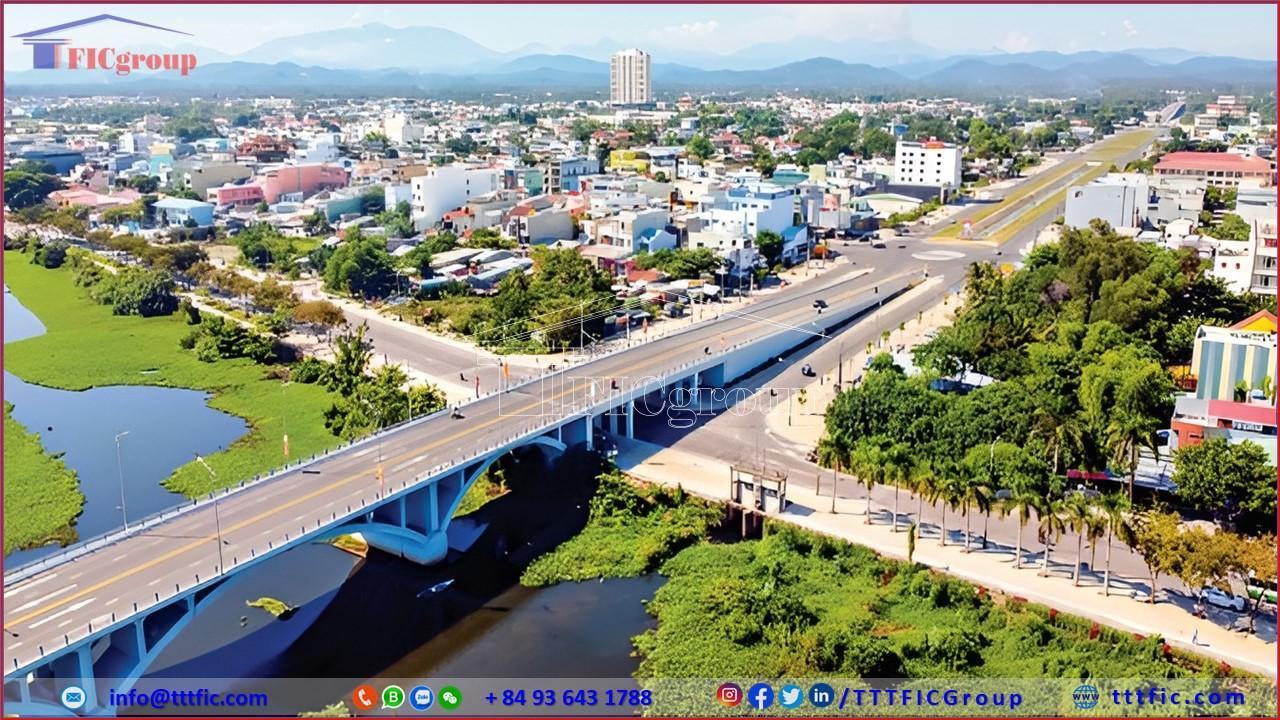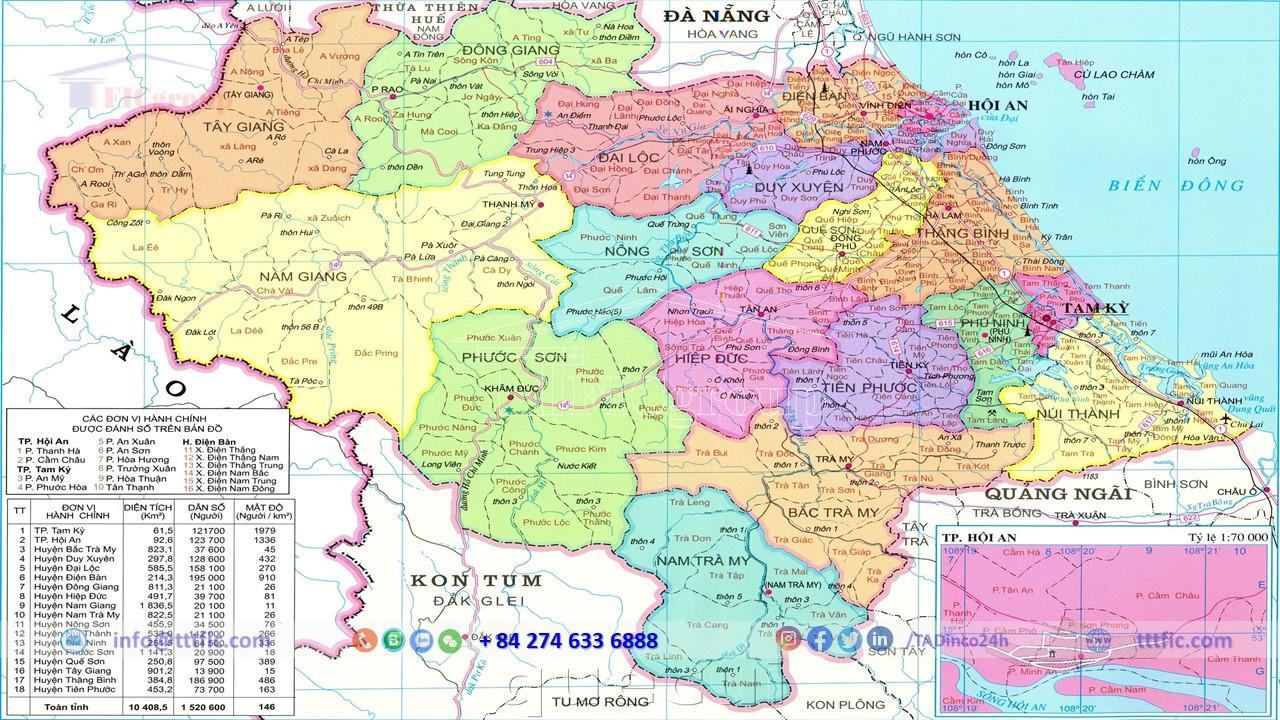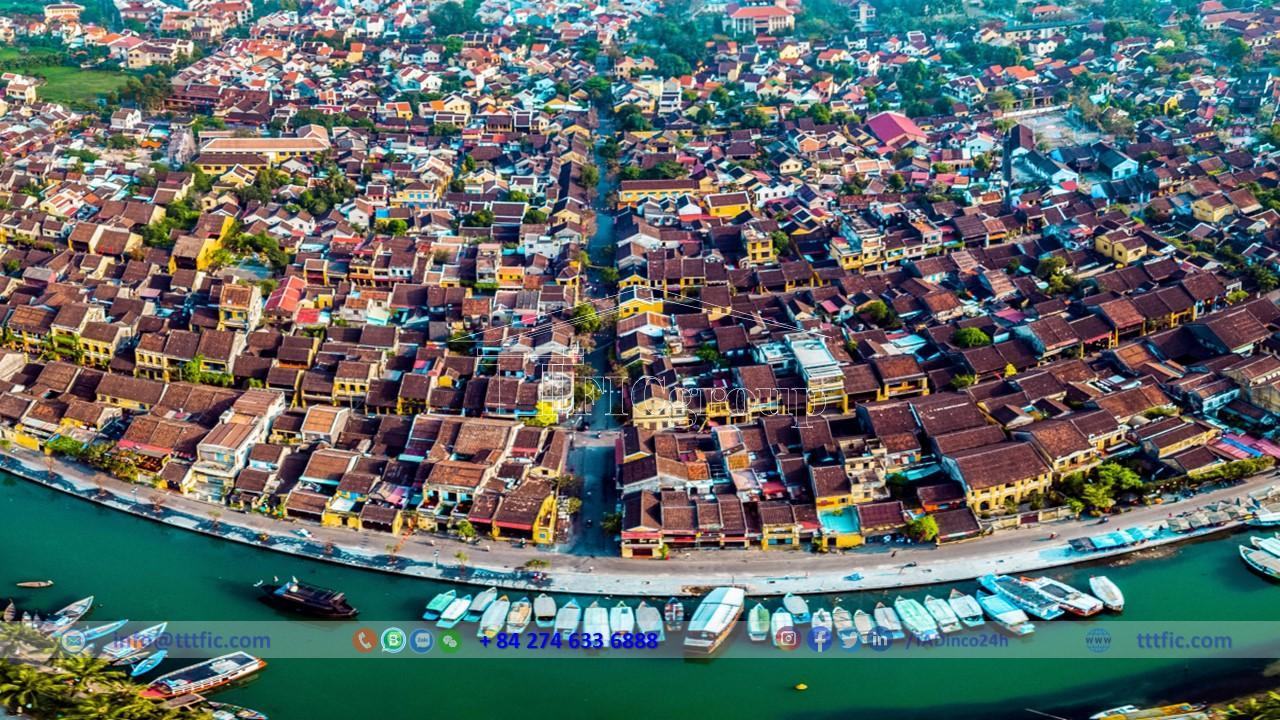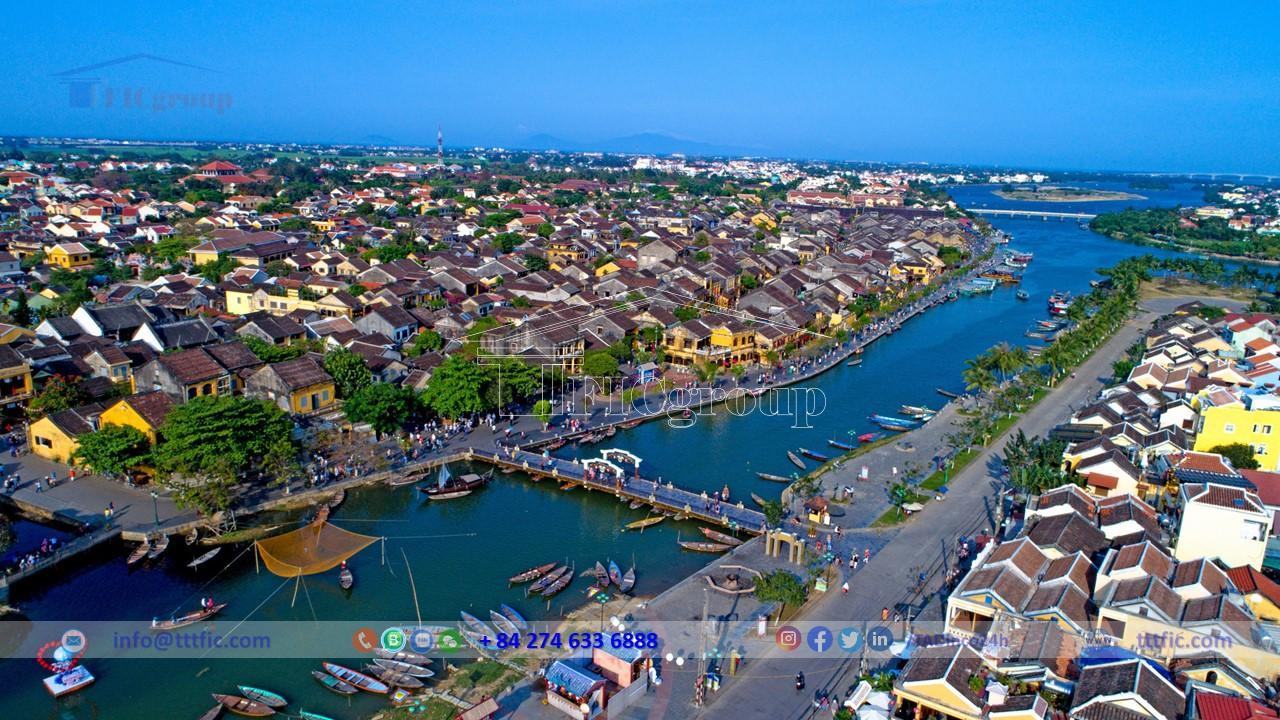Quang Nam Province:
Quang Nam province, a coastal province in central Vietnam, was reestablished in 1997 when Quang Nam – Da Nang split into two administrative units. The province features two cities, Tam Ky and Hoi An. As of 2019, Quang Nam ranked 19th in population, 17th in gross regional domestic product (GRDP), and 27th in GRDP growth rate among Vietnamese provinces, boasting over 1.5 million people and a GRDP of nearly $4 trillion VND.
In the first half of 2021, Quang Nam experienced impressive economic growth of 11.7%, ranking fifth nationally and topping the Central Key Economic Region. With its economic scale nearing 52 trillion VND, the province ranked second only to Da Nang.
Quang Nam houses the famous Chu Lai Open Economic Zone, home to THACO’s factory, which serves as a significant leverage for the Central Key Economic Region. In 2018, Quang Nam celebrated the opening of the largest and most modern Thaco Mazda car production plant in Southeast Asia.
The province, enriched with natural resources and boasting a favorable geographical location, uniquely hosts two world cultural heritage sites: My Son Sanctuary and the ancient town of Hoi An. Quang Nam’s natural beauty, including the world biosphere reserve of Cu Lao Cham Island and a stunning 125km stretch of white sandy coastline, offer vast opportunities for eco-tourism and leisure activities. The Chu Lai Open Economic Zone, the first coastal economic zone in Vietnam operating across multiple sectors, also resides within Quang Nam.

Quang Nam Province
Geography of Quang Nam Province:
Geographical location:
Quang Nam, a province in central Vietnam, is 820km south of Hanoi and 126km south of Hue. It borders Da Nang city to the north and is 900km north of Ho Chi Minh City along National Highway 1. Its boundaries also include Thua Thien Hue and Da Nang to the north, Quang Ngai and Kon Tum to the south, Sekong in Laos to the west, and the East Sea to the east.
The provincial capital, Tam Ky, and the ancient town of Hoi An lie in Quang Nam, which is roughly midway between Hanoi and Ho Chi Minh City along National Highway 1.
Quang Nam, the sixth-largest province in Vietnam, covers an area of 10,438 km² and had a population of about 1.5 million in 2019, resulting in a population density of 149 people per km².

Topography:
Quang Nam’s topography gradually lowers from west to east, forming three regions: western mountains, central highlands, and eastern coastal plains. The province lies in a tropical monsoon climate, with an annual average temperature exceeding 25°C and an annual rainfall of 2,000-2,500mm, most of which occurs during the rainy season from October to December. The two main river basins are Vu Gia – Thu Bon and Tam Ky.
Quang Nam’s natural conditions, including its weather, topography, and water resources, offer considerable potential for cultural and tourism development, such as eco-tourism and cultural tourism.
The landscape features a high mountain range in the west, a midland area in the middle, and a coastal plain in the east, with the mountainous region covering 72% of the total area. Notable peaks include Lum Heo, Tion, and Gole-Lang, with Ngoc Linh Mountain standing as the highest peak in the Truong Son Range.
The province boasts a 125km-long coastline dotted with beautiful beaches such as Ha My, Cua Dai, Binh Minh, Tam Thanh, and Bai Rang. Cu Lao Cham, an offshore island cluster with a rich ecosystem, has been recognized as a world biosphere reserve.
Climate:
Quang Nam, located in the tropical climate zone, experiences a rainy season from October to December and a dry season from February to August. Influenced by the cold northern winter, the average annual temperature is 25.6°C. The winter temperature in the plains can drop below 12°C, and even lower in the mountains. The average humidity is 84%, and the average annual rainfall is 2,000-2,500mm.
Rainfall varies across the region, with the mountainous areas receiving more rain than the plains. The northwest region of the Bung River basin receives the least rainfall, while the southwest hill region of the Thu Bon River basin has the most. Tra My is among Vietnam’s rainiest regions with annual rainfall exceeding 4,000mm. The concentrated rainfall during the rainy season in these steep and narrow terrains facilitates fast-rising floods.
The province hosts two meteorological stations, Tam Ky and Tra My, monitoring weather elements since 1976. Tam Ky station, located in Hoa Thuan, calculates weather factors for the province’s eastern plains, while Tra My station, located in Bac Tra My district, does the same for the western mountainous region.
Hydrology:
Quang Nam, home to two major river systems, Vu Gia – Thu Bon (VG-TB) and Tam Ky, is among the top ten river systems in Vietnam with VG-TB spanning 10,350 km² and Tam Ky spanning 735 km². These rivers originate from the eastern side of the Truong Son range, mainly flowing west to east into the East Sea. Truong Giang, a 47 km river running parallel to the sea, connects the VG-TB and Tam Ky systems.
The province’s dense river network, with an average density of 0.47 km/km² for the VG-TB and 0.6 km/km² for other systems, is a result of hilly terrain and heavy rainfall. These rivers offer high year-round flow, with the Vu Gia and Thu Bon rivers having average annual flows of 127 m³/s and 281 m³/s respectively.
The rivers have a distinct seasonality, with 65-70% of the annual flow occurring during the flood months (October-December) and very low flows during the dry season (February-August). January and September are transition months with irregular flows. The abundant water resources provide a solid foundation for hydropower development, with 8 large-scale and 35 small-scale hydroelectric projects operational by 2015.
Land:
As of January 1, 2010, the total natural area of Quang Nam province is 1,043,836 ha, with 798,790 ha used for agriculture, 87,765 ha for non-agricultural purposes, and 157,281 ha remaining unused.
The province’s natural area, spanning 1,043,803 ha, comprises nine different soil types, including coastal dunes and sand, river alluvium, sea alluvium, grayish soil, yellow-red soil, valley soil, and eroded gray soil with rocks and pebbles. River alluvium soils support the growth of staple food and short-term industrial crops, while the hilly regions with yellow-red soils are suitable for forestry and long-term fruit trees. Coastal sandy soils are currently exploited for aquaculture.
Forest:
Quang Nam province boasts a forest area of 425,921 ha, covering 40.9% of the land, and holds approximately 30 million cubic meters of timber. The natural forest spans 388,803 ha, while the planted forest covers 37,118 ha. Approximately 10,000 ha of the forest is rich, primarily on high mountain tops, and the rest consists mostly of poor, average, and regrowing forests, with a timber volume of around 69 cubic meters per ha.
In April 2011, Quang Nam authorities established the Saola Nature Reserve to create a corridor for mountain wildlife between Laos and Vietnam, particularly for the endangered Saola species. The province’s dominant ecosystem is the evergreen tropical broadleaf forest.
Despite its rich forest resources, overexploitation has significantly reduced the area of primary forest in Quang Nam. Recent reforestation efforts have increased the province’s forested land to over 55% by 2014, one of the highest rates in the country. The Song Thanh Special-use Forest is the largest reserve in the province, conserving the wildlife of the Central Truong Son region. The precious Ngoc Linh ginseng is primarily found at elevations above 1,000 m on Ngoc Linh Mountain.
Economy of Quang Nam province:
Agriculture, forest and aquaculture:
Agriculture:
In 2022, agricultural activity in the province showed mixed results. The total annual planting area slightly increased to over 144,000 hectares, with a rise in cereal crops but a drop in starchy tuber crops. Rice cultivation expanded to 83.2 thousand hectares, but total output decreased by 5.4% due to lower yield rates. Other crops saw varying trends: sweet potatoes and certain vegetables showed growth, while cassava and maize experienced a decrease.
The perennial crop area remained steady at over 23.6 thousand hectares. While the rubber yield increased, cashew production decreased. Fruit output stayed relatively stable with rises in banana, mango, and pineapple production.
Livestock farming held steady, boasting controlled diseases and stable prices. The livestock population saw a slight increase: buffaloes, cattle, and pigs all reported positive growth. Poultry farming, too, developed well, with the poultry population reaching 8.9 million, bolstered by good disease control and market stability.
Centralized farming is gaining traction, with 347 farms operating across various districts. Despite a relatively stable disease situation, African swine fever and Nodular skin inflammation remain concerns, affecting several districts. No bird flu outbreaks have been reported. This overall scenario reflects the province’s balanced approach towards agricultural growth, maintaining an equilibrium between crop and livestock farming.
Forest:
Forestry production in the first nine months of 2022 continued to grow compared to the same period last year. The province planted approximately 9.6 thousand hectares of new forest area (+2.5%; +238 ha), and dispersedly planted over 4.7 million trees (+2.9%; +133 thousand trees). The harvested timber volume exceeded 1.22 million cubic meters (+4.8%; +55 thousand cubic meters), and the harvested firewood volume reached 352 thousand steres (+0.2%; +540 thousand steres).
Fire prevention, firefighting, and forest protection efforts have been reinforced, resulting in a reduction of forest fires in terms of both the number of cases and the area damaged. Since the beginning of the year, only five fires have occurred (-45 cases), affecting 0.75 hectares (-626.8 hectares). There have been 24 cases of deforestation (-2 cases), with a damage area of 13.89 hectares (+4.39 hectares) compared to the same period in 2021.
Aquaculture:
The total seafood production in the first nine months of 2022 reached 107.3 thousand tons (+2.4%; +2.5 thousand tons) compared to the same period in 2021. The seafood harvesting volume was 83 thousand tons (+2.4%; +2 thousand tons), of which 76.1 thousand tons came from sea fishing, accounting for 91.7% of the total harvest volume. Inland harvesting was about 6.9 thousand tons (+2.8%; +0.2 thousand tons).
Weather conditions were favorable for sea fishing. Main fishing activities included trolling, purse seining, trawling, jigging, dragnet fishing, and pot fishing. Main catch species were tuna, mackerel, sardine, golden threadfin bream, chub mackerel, and cuttlefish.
Although there were challenges due to fluctuating fuel prices and diminishing profits, fishermen strived to calculate costs appropriately for each trip. There were 2,860 mechanized vessels fishing, a 3.6% decrease (-108 boats) compared to the same period in 2021. Less efficient boats with engines under 20 horsepower were being phased out in favor of larger boats for offshore fishing.
The total area for seafood farming in the first nine months of 2022 was nearly 5.5 thousand hectares (+3.2%; +171 ha), including 1.9 thousand hectares for fish farming (+5.7%; +102 ha) and over 2.9 thousand hectares for shrimp farming (+2.1%; +61 ha).
The seafood farming yield for the first nine months was nearly 24.2 thousand tons (+2.4%; +565 tons). Diseases affected 469 hectares of the farming area, including damage from heavy rain flooding 195.5 hectares and diseases affecting 274 hectares.
There are 38 hatcheries in the province, including one freshwater fish hatchery, 34 whiteleg shrimp hatcheries, and three saltwater fish hatcheries. The total yield of hatchlings produced and supplied to the market was over 338 million (+7.5%; +23.4 million) compared to the same period last year.
Industry:
In Q3 2022, the industrial production index (IIP) saw a decline of 9.1% from the previous quarter, though it increased by 53.7% compared to the same quarter in the prior year. Various sectors showed mixed results, with mining decreasing by 19.6%, processing and manufacturing dropping by 10.6%, while power production and distribution grew by 6.4% and water supply and waste management went up by 3%.
The first nine months of 2022 revealed an overall IIP increase across all industries by 30.3% year-over-year, driven primarily by high growth in the processing and manufacturing sector, notably in car production and assembly. The power production sector also saw significant growth due to the operation of the Dak Mi 2 hydropower plant.
Nevertheless, the expiration of Decree 103/2021/ND-CP led to decreased consumer demand, negatively impacting the domestic car market and car production in Q3. This caused a decline in the motor vehicle industry’s IIP to 85.4% compared to Q2.
Certain industries experienced notable IIP increases during the first nine months of 2022, while others like coal mining, food processing, textile, medicine production, and furniture production saw a decrease. Additionally, the production of certain industrial products declined in Q3 2022.
The consumption index for the processing and manufacturing industry declined significantly in September 2022 compared to the previous month and the same period in 2021. The inventory index, however, increased compared to the same period in 2021, despite a slight decrease from the previous month.
By September 2022, the labor use index in industrial enterprises rose by 10.5% year-over-year, mainly in non-state and foreign-invested enterprises, even though the state enterprise sector saw a significant decline. Different industries showed varied labor use index changes.









